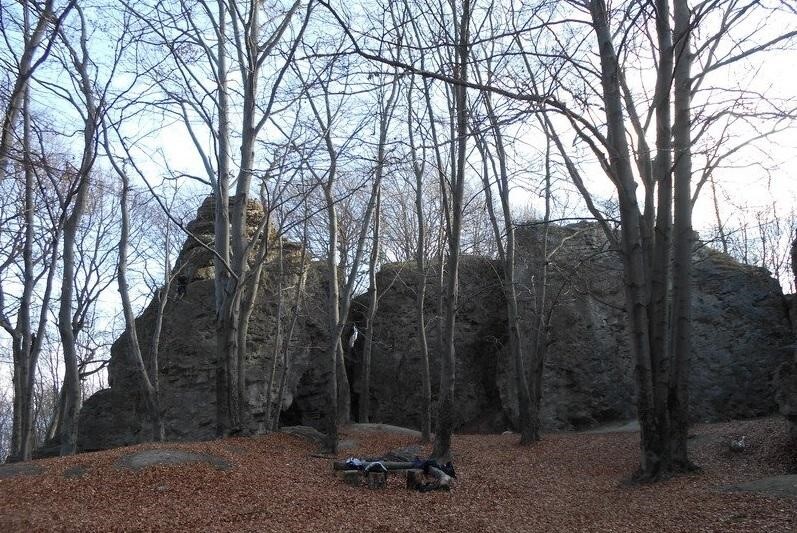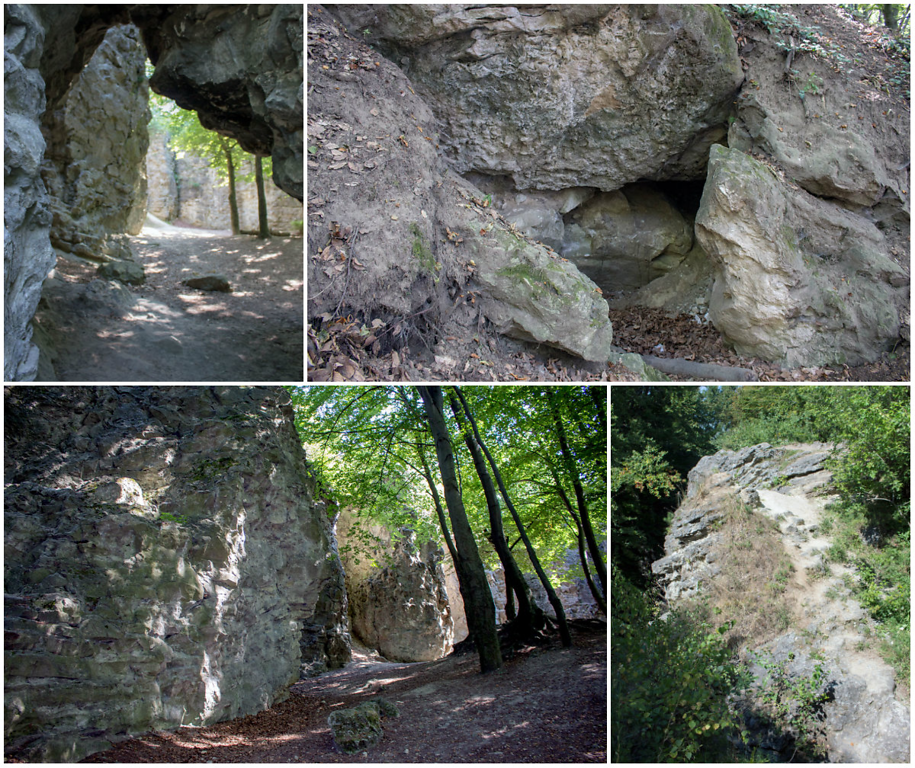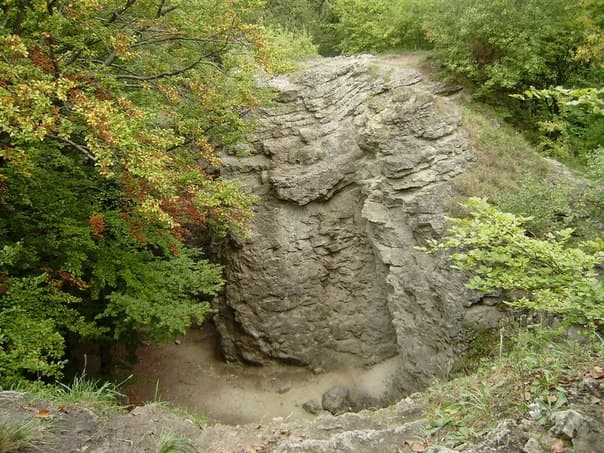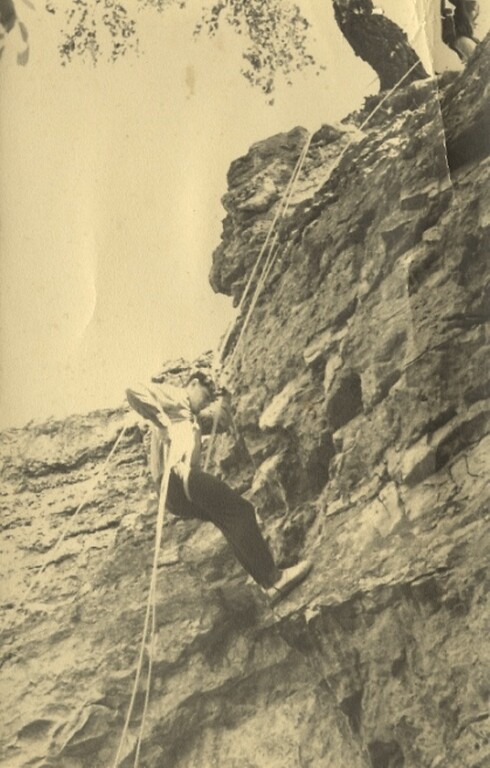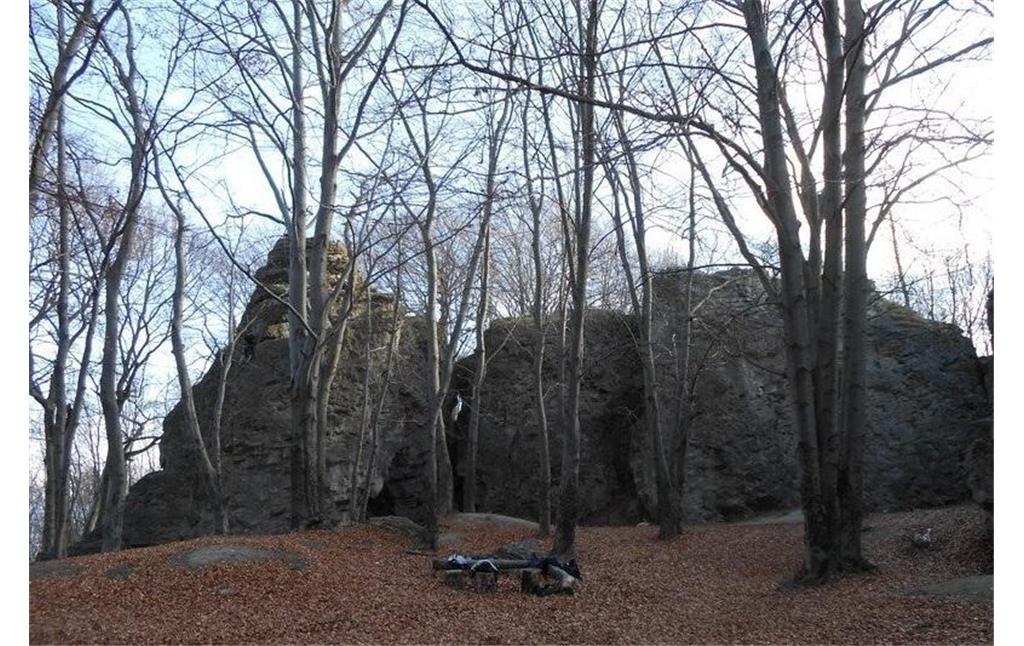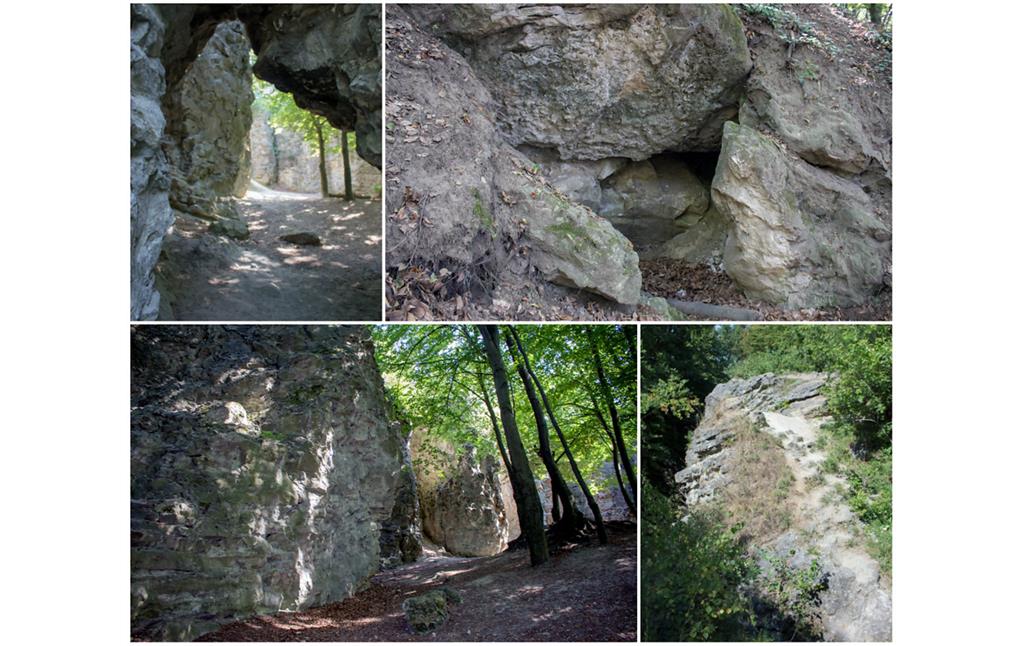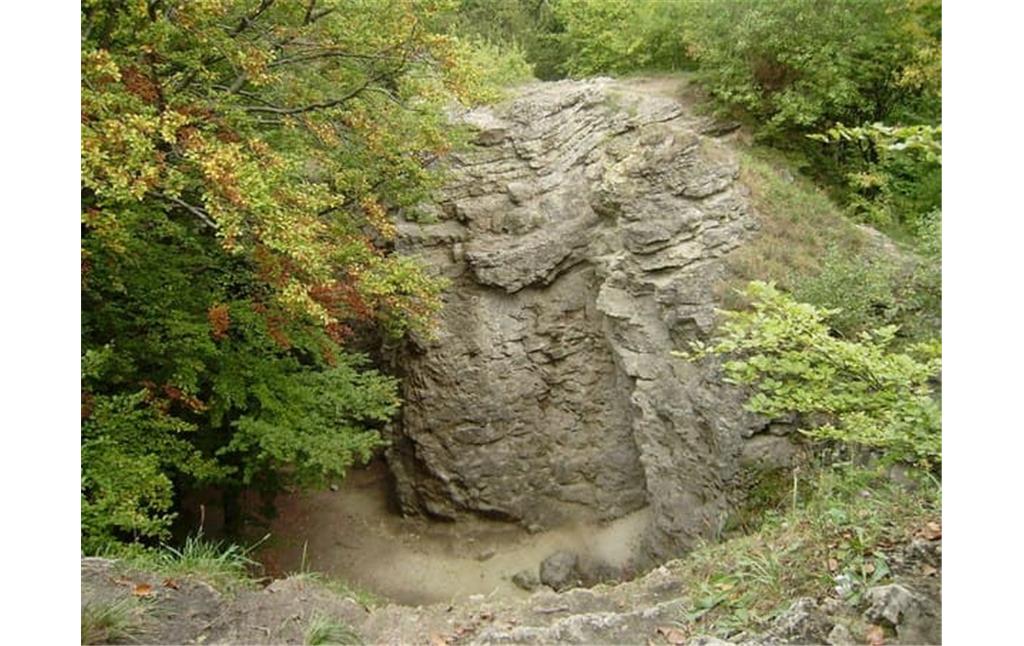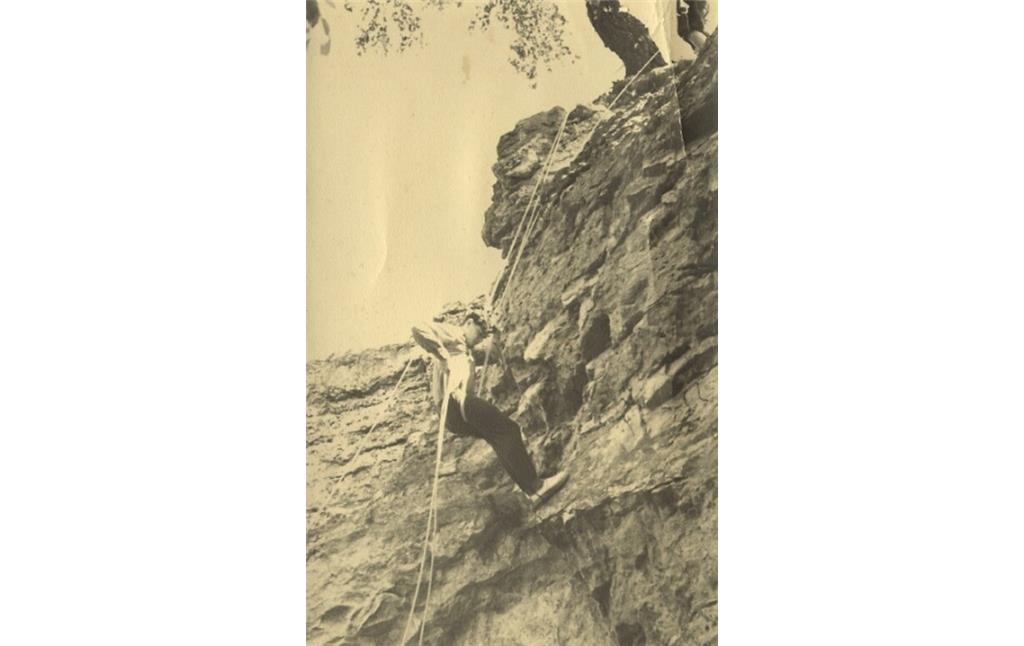
The name
More often Chotov Rocks (or Chotov Rock) are called Devil's Rocks. There is even a legend about how the devil carried this rock to destroy a Christian church in Lviv. But many historians agree that the rocks are called Choto. The name is obviously connected with the word chat (stand on chats) and testifies to the ancient purpose of the rocks as a guard post on the eastern approaches to Lviv.
Archeology
The Lviv Regional Expedition by the Institute of Ukrainian Studies (Ivan Krypiakevych National Academy of Sciences of Ukraine) opened and inspected the Devil’s Rocks in 1973. In the upper horizon there are materials of the 18th-20th century, as well as fragments of utensils of the Early Iron Age (Scythian period) and numerous bones of animals, in particular domesticated ones. Remains of only wild animals (red and northern deer, foxes, badgers, birds, etc.) and flint products, scrapers and knives were found at depths of 50–65 to 135–140 centimeters. The age of these findings is 8,500 years from the present (determined by C14-analysis). Remains of mammoths, reindeer, birds, and other animals were found on 135-140 to 200-205 centimeters below, and scrapers, cutters, and knives (13,500 years ago) made of flint were found. Below 205 centimeters the bones of a mammoth, reindeer, primitive horse and other animals were found, and from stone and bone products - scrapers, knives and piercings. The complex dates to the late Paleolithic (27,200 years ago).
According to archaeologists, under the rock was the oldest settlement in Lviv - a hunting camp. It existed before the Kyrylov Parking in Kyiv (19,000 years ago) and the settlement on Spazysta Street in Krakow (25,000 years ago). Ancient hunters hunted mammoths, cave bears and lions in what is now Lviv. Remains of material culture from the time of King Danylo (1201-1264) and his son Lev (1225-1301) were also found in the upper deposits in the Lviv VII canopy.
History since the Middle Ages
Archaeologists have found remnants of the culture of King Danylo (1201-1264) time on the territory of Chotova Rock. The name of the rock „Devil“ is modern. Earlier, the rock was called „Chatova“ because the locals chatted from it when the Tartars approached.
The historical events connected with the rock attract attention: the High Castle, Lysa Hora, as well as the Devil's (Chatova) rock were observation points where the prince's chats were located, guarding the approaches to ancient Lviv. The legend of „devil's names“ spread in Galicia did not escape the rocks. In the middle of the 19th century Isidor Sharanevych, a researcher of the history of the Galicia-Volyn principality, claimed that the original Lviv should have lay on Chotova Rock, because it was the highest place where one could see the radiance of the burning Hill in 1256. This has been confirmed by recent studies: archaeological excavations conducted on the territory of Chotova rock by specialists of the Institute of Ukrainian Studies, opened the oldest hunting camp-settlement on the territory of modern Lviv. They found the cultural remains of the time of King Danylo.
In the 19th century the Lviv historian Ludwik Zelinsky wrote about the ruins of a pagan castle on Chotov Rocks that was built in the 8th century. In the 17th century a Lviv nun, and at the end of the 18th century a burgher called Gertrude, confirmed that they saw the ruins of ancient walls and the castle on the rocks. The remains of the shafts can be seen near the rocks also today.
The Chotova rock was carefully guarded by the abbot of the Benedictine convention, Joseph Kuhn. He created a step on the rock with a handrail, and on top put a gazebo with a sharp roof and porch. This structure was called the shrine of Apollo or Muses. The abbess himself described the Chotova rock and the outskirts of the city in a collection of poems „Lembergs schönste Umgebungen“ („Beautiful suburbs of Lviv“, German, 1834). Joseph Kuhn was suspected by the Austrian authorities of participating in revolutionary circles and taken from Lviv to Styria. In the second half of the 19th century, in 1881 (according to other sources, from 1904 to 1906), the monks built a monastery under the rock, where they lived in the summer, and later completed the church. Interestingly, local history sources mention the first monastery, built in 1595 by the Sharipovsky sisters from Kolomyia, who exchanged their lands in Kolomyia for Chotova Skelia and Lysynychi.
During several wars were battles next to the rocks: with the Turks in 1672, with the Tatars in 1695, with the Bolsheviks in 1920. In the autumn of 1648, the Cossack-peasant liberation army led by Bohdan Khmelnytsky approached Lviv. Its main detachments were near Chotova Rock. The hetman himself looked at Lviv from its top and observed the location of his camp between the villages of Lysynychi and Kryvchytsi, which is why the people still call this tract camp. In 1655, Ukrainian-Moscow troops again passed near Chotova Rock during the second siege of Lviv.
In 1672, with the Turkish-Tatar invasion of Lviv, part of the peasants of the surrounding villages and some suburbs hid with their families and property in the woods near Chotova Rock. During the last Tatar invasion of Lviv in 1695, for several nights on Chotova Skelia, on behalf of the defenders of the city, the scout watched the movement of the Tatar hordes, closely watching where their attack on the Lviv fortress would take place.
After the proclamation of the Western Ukrainian People's Republic in late November 1918, battles for Lviv between the Ukrainian Galician Army (UGA) and the Polish Army took place on the territory of Lysynychi. When the UGA left Lviv in November 1918, Chotova Rock stayed in the hands of the UGA for several more months. In the winter of 1918/1919, units of the group „East” fought in the vicinity of the cliff, and since then, trenches have remained that cut through the forest. And on the rock itself was an observation post for adjusting artillery fire.
Legends
There exist more interesting legends about the Devil's (Chatova ) Rocks. Here are some of them:
The first legend. According to legend, the devils scattered large stones, and one of them fell in the Vynnykivsky forest, one near the village of Penyakiv, another near Pidkamin. That is why the rock in the Zhupan forest was popularly called Chortova (Chortovska).
The second legend says that once the devil was on his way to destroy the Cathedral of St.Yuri in Lviv. The local population says that the evil force has power until the first night, because as soon as the first rooster crows, the devil immediately weakens. They gathered and decided to throw a whole rock on the cathedral. Behind Vynnyky was just such a rock, and the devils thought that it could well crush the cathedral. They chose a night when there were almost no stars in the sky, embraced the rock with their hands and took it off into the air. The rock was cursed and so heavy that he could hardly carry it. So, he flew, then rested, and only when he was halfway between Vynnyky and Lviv, the roosters sang, and a whirlwind blew at the Town Hall. Suddenly, all the devil's strength diminished, the rock slipped from his hands and crashed into the woods on the hill. It still stands there. And if you look closely, you can see traces of the devil's claws.
The third legend is even more interesting. Nobody knew where the dragon that settled near Lviv on the Devil's Rocks came from. On a fine day, he warmed his mighty body on the rocks, lazily squinting sleepy eyes. When evening came and the shadows of tall pines fell to the ground, the dragon came to life - at first it stretched with a crunch, spreading its powerful paws, then scraped its sharp claws on the stone, until the sparks flew, and finally tore the air with a loud growl. From his roar the trees shook, the stones rumbled, until the echo rolled and watered the city with fear. There was a time when the dragon killed just for fun. It was difficult to get from Lviv to Vynnyky, because the monster was lurking in the woods on the hills and was just waiting for a reckless traveler.
But in the end, the people of Lviv made such an agreement with the dragon that they would bring cattle to feed it. And besides, to bring a young maiden every month. On rainy days, all the girls put papers with their names in their hats, and messengers with hats went to the most dragon cave and put their hats in front of the monster. The snake sniffed the papers for a moment, and when it blew, they all flew up like petals. Only one piece of paper remained. The envoys returned, carrying sorrow in their hats for some, and salvation for the city.
It went that way for over a year, until it was the turn of the blacksmith's daughter, Yaryna. The news was brought to her just before the wedding. The whole family burst into tears, and they had to equip the smithy for death that evening. Her fiancé was a hunter and a desperado who often went to bears with only a horn. But a dragon is not a bear. He may have been killed, but he won't let you in, he'll be swept away by the hot flames.
“You know what,„ said the hunter to the blacksmith. “What are you talking about?” He wondered. „The dragon is waiting for the maiden.“ He won't be satisfied with you.
„He'll get a maiden,“ the hunter smiled. „I'll be that maiden.“ Just put linen yarn on your head and attach a wreath.
„My God!“ The messenger, who was to escort the offering to the serpent, was horrified. „The same dragon will kill everyone when he exposes the deception!“ „He won't have time to expose,“ said the young man. - „Let's go”.
And they went with the messenger to the Devil's Rocks. The messenger trembled all the way and whispered prayers, and the hunter gripped the sword hidden in the folds of his wide dress. The dragon was already waiting. Not a shadow of suspicion flashed in his eyes. He saw in front of him a slender pretty girl with lush wavy hair that fell on her slightly broad shoulders. The messenger bowed and hurried to leave the horrible place, and the young man boldly moved to the snake. He lay to himself, purring lazily under his breath, and devoured his favorite delicacy with a greedy look. “Now he will enjoy the tender maiden's flesh” - with this intoxicating thought, the dragon lifted his head from his paws and opened his paw. But what is it?! Suddenly the maiden made a harsh movement and a sharp sword flashed in the air. For a moment the dragon cried out in surprise. There was a suspicion in his not-so-smart head that the maiden could not have the power to wield a double-edged sword like a spindle. But this was his last thought, for the next moment black steaming blood erupted from the severed dragon's neck and, like resin, rattled on the fireplace. Another blow, and the serpent's head rolled to the foot of the rocks. His head was taken away by a brave hunter, and his body was torn apart by forest animals and birds. But you can still see traces of dragon claws on the rocks.
The fourth legend is about the key to the treasure under the Devil's Rock. For a long time, the city guard hunted for the robber Fedko Chugai, but eventually they captured and imprisoned him. For several days, the executioner tried to get out of the prisoner at least something about his comrades and their hiding places, but all in vain. Lying exhausted without a piece of living space on his body, Fedko dreamed of his friends and how they would break into the Market on swift horses and save him from execution. Finally his last day came. Early in the morning, Fedko was taken out of the torture chamber. He had a bandage around his neck, the end of which was held in the hand of the executioner. Guards, armed with halberds and flint, surrounded them on all sides.
The gallows were already waiting near the Town Hall. Fedko threw restless eyes around, trying to recognize his fellows in the crowd of interesting people. He could not know that part of his band of robbers had died the day before during a raid, and the rest had been dispersed and escaped to remote farms. When he finally realized that there would be no salvation, he passed the death sentence with sadness and indifference. He also mechanically kissed the cross on the priest and confessed. And only after following the executioner on the ladder, as if born again. He looked at the crowd and shouted:
„Hey, people! I buried gold and silver money near the Devil's Rock under the spruce! They're hidden in an iron chest, and here's the key to it.”
With that, he dropped the metal cross from the priest's neck and held it out in his hand. The executioner had just noticed that the cross had serrations, such as in a key. His eyes went to his forehead, which he had not guessed before, because he would have climbed out of the skin, and would have extracted his treasure from Fedko. But no one from the crowd moved for the key, and then the executioner held out his hand behind it, but Fedko swung his right hand, and the key flew at people's feet. Maybe someone picked it up, but in an instant a black dog appeared from somewhere, grabbed the key to his mouth, and while someone woke up, he disappeared without a trace.
The fifth legend. In 1648, a camp of Bohdan Khmelnytsky's troops was located near the village of Lysynychi. On the Chat Rocks (as they were then called) was a watchtower from which all the surroundings could be seen. The Cossacks captured it without much effort and held it even when the main troops of Bohdan Khmelnytsky were forced to retreat from Lviv due to the betrayal of the Crimean Tatar khan. Polish troops still gained this important strategic point on the outskirts of Lviv, but at the cost of very large losses. One of them said then that these were real Devil's Rocks, not Chat. So, this name was attached to the rocks. Modern fans of renaming want to return the rocks to their former name “Chat„, because the name “Devil„, they say, was given by the Poles. That's right. Just why was it given such a name? Because the Cossacks fiercely defended them, that is, the name reflects the heroism of the Cossack troops.
There are more short legends among the people about the rocks:
- On the rock once was the castle of the boyar Igor, called Eagle. Maybe that's why the highest of the rocks is called “Eagle's Nest„. In Austrian times, the rock was turned into a quarry.
- An interesting legend is attributed to the Vynnyky rocks, believing that it protects the city from hail and storms. The lokal residents say that, as soon as clouds cover the top of the trees it looks like “The devil lit a fire„.
- Older inhabitants claim that during the Second World War the Germans wanted to blow up the rock and pave a direct road to Lviv, but surveyors found that deep under the rock is an underground lake, and only this saved it from destruction.
- Chotova rock and forest were the property of the Saporovsky family, who presented them to Lviv Benedictine nuns. At the end of the 17th century one nun said that she had seen here the remains of the walls and dumps of a castle - the news is not very certain. Rock dumps once occupied a much wider area than now, later they were destroyed.
- From the first half of the 19th century Chotova rock attracted numerous travelers from Lviv. Then it was sung in poetry and fantastic epics were written about (alleged) past events on the rock: about Prince Igor, who had his castle here, fought with his brother Volodar and wanted to take away his wife Adele.
(Oksana Shemchyshyn, Lviv Polytechnic National University, 2021)
